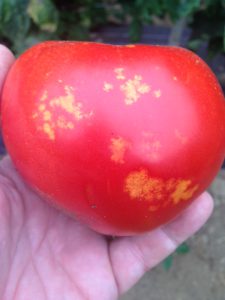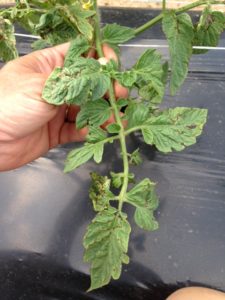Sweet Corn
European corn borer (ECB) moth catches in black light traps remain very low. The second flight is proving to be very erratic, with some locations getting low numbers of moths while other regional traps catch none. There will be no map in this edition. Second generation feeding is often obscured by fall armyworm (FAW) feeding. Once plants hit full tassel, any ECB larvae present will move downward on the stalk and re-enter the plant near the area where ears are forming. This can result in direct injury to the ear. Growers should consider an insecticide application at the full tassel stage to target ECB larvae as they migrate downward. This application can eliminate larvae that have escaped any earlier insecticide applications.
The highest nightly trap catches of ECB for the week ending 8/08/18 are as follows:
| Allamuchy 1 | Flanders 1 |
| Belvidere 1 | Medford 1 |
| Denville 1 | Pedricktown 1 |
| Eldodra 1 | Springdale 1 |
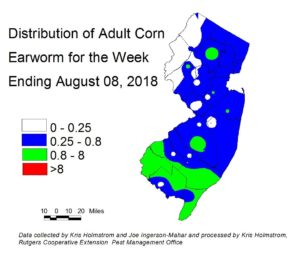 The corn earworm (CEW) situation remains largely unchanged from the previous week. While CEW numbers have been somewhat inconsistent, we continue to have significant black light trap catches in all regions of the state. The CEW pheromone trap network in the southern counties is showing a similar situation (see CEW blacklight map at left, and pheromone trap map at lower right). There are many fewer pheromone traps than blacklight traps. This results in much broader colored patches on the pheromone maps. The blue area on the blacklight map indicates an approximate 4-5 day silk spray schedule, while
The corn earworm (CEW) situation remains largely unchanged from the previous week. While CEW numbers have been somewhat inconsistent, we continue to have significant black light trap catches in all regions of the state. The CEW pheromone trap network in the southern counties is showing a similar situation (see CEW blacklight map at left, and pheromone trap map at lower right). There are many fewer pheromone traps than blacklight traps. This results in much broader colored patches on the pheromone maps. The blue area on the blacklight map indicates an approximate 4-5 day silk spray schedule, while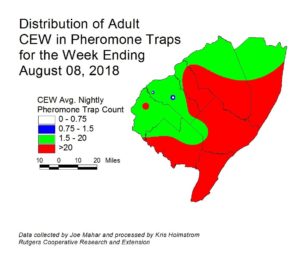 green would be 3 days. On the pheromone map, the green area corresponds to a 3-5 day schedule, with red indicating a solid 3 day schedule depending on location. Trap catches from North Carolina and Virginia are showing signs of increase now, although even in these states, catches are somewhat inconsistent. We should expect the current situation to continue, with a possible increase in CEW population locally as we progress through mid-August and beyond. Growers of Attribute I and Performance Series sweet corn (expressing B.t. traits) should consider adhering to silk spray schedules prescribed for non B.t. sweet corn. At this time, Attribute II varieties are not known to support CEW larvae.
green would be 3 days. On the pheromone map, the green area corresponds to a 3-5 day schedule, with red indicating a solid 3 day schedule depending on location. Trap catches from North Carolina and Virginia are showing signs of increase now, although even in these states, catches are somewhat inconsistent. We should expect the current situation to continue, with a possible increase in CEW population locally as we progress through mid-August and beyond. Growers of Attribute I and Performance Series sweet corn (expressing B.t. traits) should consider adhering to silk spray schedules prescribed for non B.t. sweet corn. At this time, Attribute II varieties are not known to support CEW larvae.
The highest nightly black light trap catches of CEW for the week ending 8/08/18 are as follows:
| Califon 2 | Milltown 2 | Farmingdale 1 |
| Centerton 2 | Pedricktown 2 | Green Creek 1 |
| Denville 2 | Tabernacle 2 | Jones Island 1 |
| East Vineland 2 | Woodstown 2 | Old Bridge 1 |
The highest nightly pheromone trap catches of CEW for the week ending 8/08/18 are as follows:
| Green Creek 102 | Pedricktown 19 | Beckett 1 |
| Berlin 38 | East Vineland 13 | |
| Woodstown 26 | Jobstown 4 | |
| Elm 23 | Monroeville 2 |
Silking Spray Schedules*:
South – 3 days
Central – 3-4 days
North – 5 days
*These recommendations are based on regional catches. Adhere to tighter spray schedules if indicated by local trap catches.
Fall Armyworm
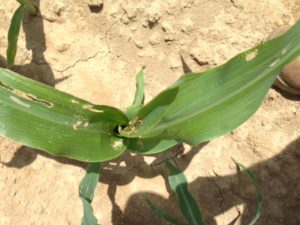 Fall armyworm (FAW) infestations continue to be light and spotty, although coastal regions
Fall armyworm (FAW) infestations continue to be light and spotty, although coastal regions are starting to show signs of gradual increase. Pheromone trap catches remain low. Continue scouting regularly for this pest. Look for significant injury in whorls, with all damage leading directly into the center of the plant (see photo at left). FAW larvae consume lots of tissue, and grow rapidly (see photo at right). Be sure to check seedling stage plantings as well, as FAW will attach even small plants. Consider treating if plants infested with FAW alone, or in combination with ECB exceed 12%. FAW is resistant to synthetic pyrethroid insecticides. Effective materials include those in IRAC groups 5 (Radiant, Entrust (OMRI approved)), and 28 (Coragen, Exirel).
are starting to show signs of gradual increase. Pheromone trap catches remain low. Continue scouting regularly for this pest. Look for significant injury in whorls, with all damage leading directly into the center of the plant (see photo at left). FAW larvae consume lots of tissue, and grow rapidly (see photo at right). Be sure to check seedling stage plantings as well, as FAW will attach even small plants. Consider treating if plants infested with FAW alone, or in combination with ECB exceed 12%. FAW is resistant to synthetic pyrethroid insecticides. Effective materials include those in IRAC groups 5 (Radiant, Entrust (OMRI approved)), and 28 (Coragen, Exirel).
Pepper Weevil
As far as is known, no weevils have been trapped outside of the Hammonton area.
Beet Armyworm (BAW)
Pheromone trap catches of BAW in southern NJ are low in general, and the previous weeks’ higher catch sites have moderated. At this time, there are no known field infestations.
Native brown stinkbugs are active in tomatoes now. Stinkbug damage can be an economic problem for our field tomato plantings through September. Stink bug feeding results in pale blotches on green fruit, that turn yellow as the fruit ripen to red (see photo at right). Picking crews often notice this damage first, as they see the greatest volume of overall fruit. If this damage is increasing, and/or adults, nymphs or egg masses are occurring in scouting samples, consider treating. See the tomato section of the 2018 Commercial Vegetable Recommendations Guide for 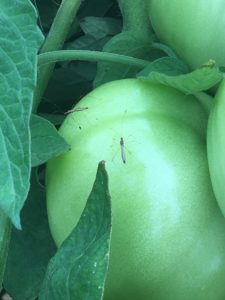 appropriate materials.
appropriate materials.
In the northern and central counties, high tunnel tomato production is ongoing. In the tunnels, stilt bug (see photo at left) populations are increase and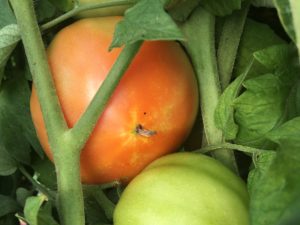 causing damage (see photo at lower right) tomatoes. Stilt bug injury is generally less severe than stink bug injury. However, growers should assess damage levels (if present) and determine if it rises to the level of actionable. Insecticides that are effective against stink bugs would likely be effective for stilt bugs, if control is deemed necessary.
causing damage (see photo at lower right) tomatoes. Stilt bug injury is generally less severe than stink bug injury. However, growers should assess damage levels (if present) and determine if it rises to the level of actionable. Insecticides that are effective against stink bugs would likely be effective for stilt bugs, if control is deemed necessary.
With very warm, wet weather, foliar diseases of tomatoes are increasing. Be sure to monitor the tomato/potato disease forecasts generated from the RAREC station. This information appears weekly via the Plant and Pest Advisory and is useful for calculating spray schedules necessary for 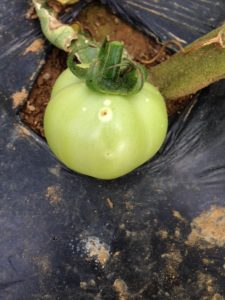 early blight. Bacterial infections are particularly common now. Bacterial leaf spot (BLS) (see photo at left) is showing up to some degree in most scouted plantings in the northern counties, and bacterial canker is present in a number of locations as well. BLS causes small, very dark lesions on all ages of foliage. When these lesions occur on juvenile tissue, the leaves often become distorted as they expand and mature. Bacterial canker can cause a marginal necrosis, typically on older foliage. Pale streaks form on petioles and a characteristic fruit lesion called bird’s eye spot (see photo at right), forms on the fruit. Labeled products are found in the tomato section of the 2018 Commercial Vegetable Recommendations Guide.
early blight. Bacterial infections are particularly common now. Bacterial leaf spot (BLS) (see photo at left) is showing up to some degree in most scouted plantings in the northern counties, and bacterial canker is present in a number of locations as well. BLS causes small, very dark lesions on all ages of foliage. When these lesions occur on juvenile tissue, the leaves often become distorted as they expand and mature. Bacterial canker can cause a marginal necrosis, typically on older foliage. Pale streaks form on petioles and a characteristic fruit lesion called bird’s eye spot (see photo at right), forms on the fruit. Labeled products are found in the tomato section of the 2018 Commercial Vegetable Recommendations Guide.
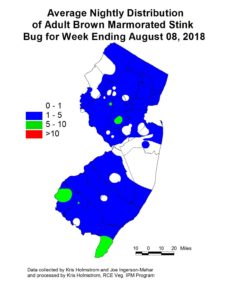 Brown marmorated stink bug (BMSB)
Brown marmorated stink bug (BMSB)
BMSB catches in black light traps increased dramatically over the past week, with heaviest catches occurring in western Salem and Cape May counties. Although this pest has not had serious impact on vegetable crops like peppers in recent years, it is still a significant pest of tree fruits.
The highest nightly trap catches of BMSB for the week ending 8/08/18 are as follows:
| Green Creek 12 | Centerton 6 | East Vineland 3 |
| Hillsborough 9 | Eldora 6 | Jobstown 3 |
| Princeton 8 | Denville 4 | Pedricktown 3 |
| Woodstown 8 | Little York 4 | South Branch 3 |
Pumpkins and Winter Squash
 As per Dr. Wyenandt’s recent cucurbit downy mildew (CDM) alerts, all growers should be applying appropriate DM fungicides on all cucurbit plantings now. CDM has been found on pumpkins and butternut squash in Cumberland County and on cucumbers and butternut squash in Hunterdon County and cucumbers in Salem
As per Dr. Wyenandt’s recent cucurbit downy mildew (CDM) alerts, all growers should be applying appropriate DM fungicides on all cucurbit plantings now. CDM has been found on pumpkins and butternut squash in Cumberland County and on cucumbers and butternut squash in Hunterdon County and cucumbers in Salem and Warren counties. CDM causes yellow “panels” to develop on the upper leaf surface (see photo at left) with dark sporulation forming on the lower leaf surface (see photo at right). CDM can defoliate fields in a matter of several days during wet conditions such as we are currently enduring. Our present weather pattern has New Jersey cucurbit crops under constant threat of CDM infection from spore sources locally and from more southern sources. For detailed CDM forecasts, see the following website: http://cdm.ipmpipe.org/ All growers are encouraged to check this website at least once a week. Through Tuesday of this week, NJ was considered to be at moderate-to-low risk for spread from existing known sites.
and Warren counties. CDM causes yellow “panels” to develop on the upper leaf surface (see photo at left) with dark sporulation forming on the lower leaf surface (see photo at right). CDM can defoliate fields in a matter of several days during wet conditions such as we are currently enduring. Our present weather pattern has New Jersey cucurbit crops under constant threat of CDM infection from spore sources locally and from more southern sources. For detailed CDM forecasts, see the following website: http://cdm.ipmpipe.org/ All growers are encouraged to check this website at least once a week. Through Tuesday of this week, NJ was considered to be at moderate-to-low risk for spread from existing known sites.
